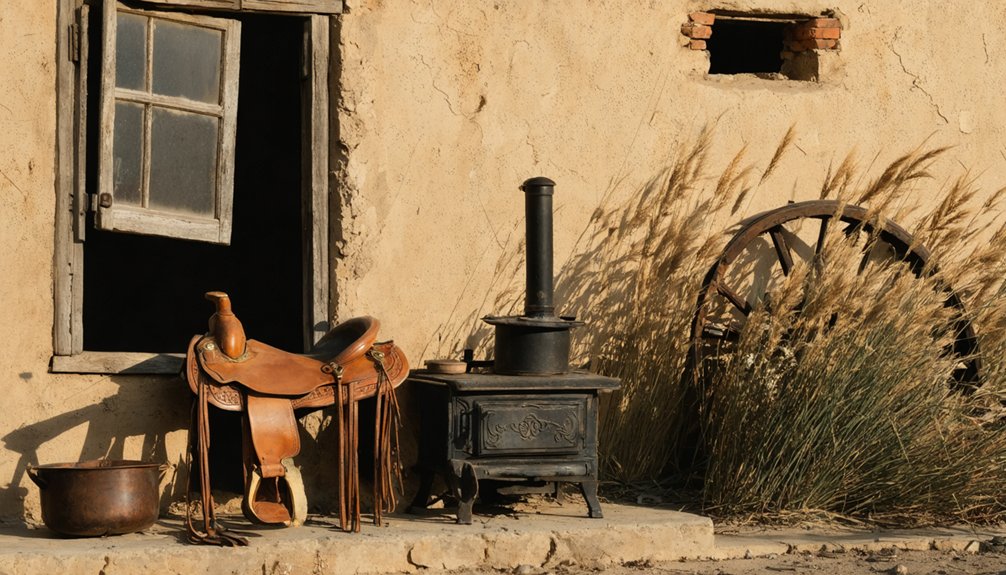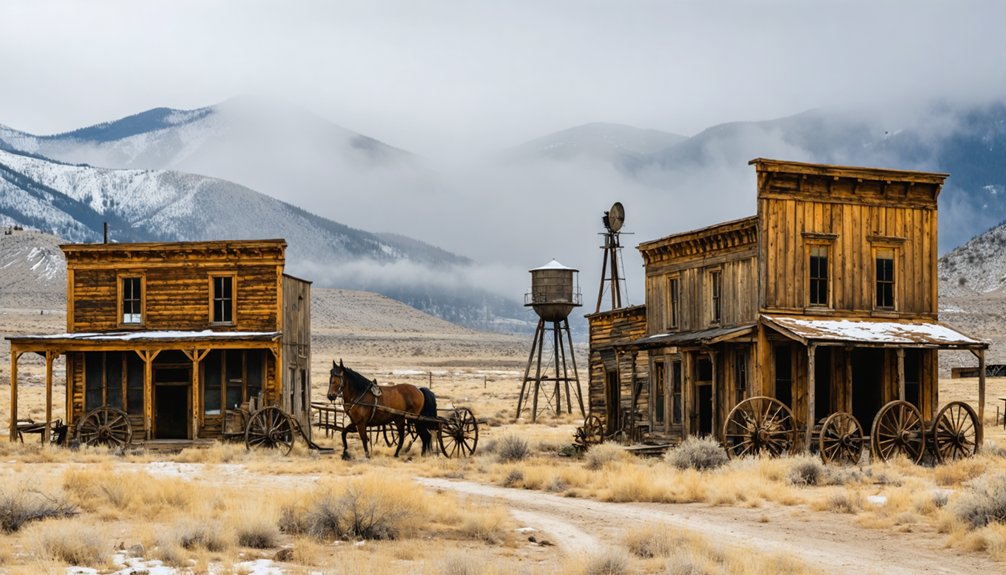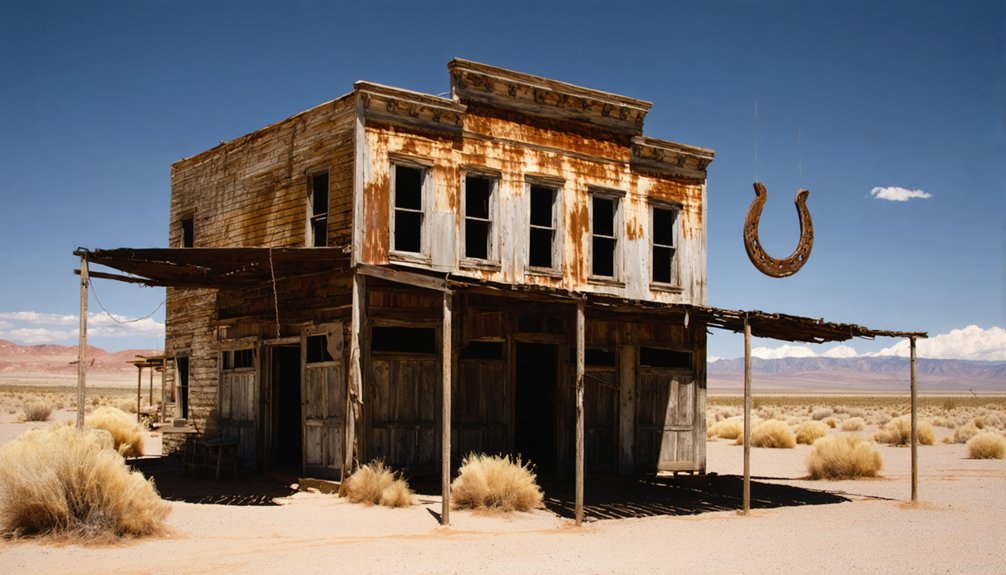When exploring abandoned pioneer towns, you’ll find five key traces of frontier life: structural foundations with cellar holes revealing settlement patterns; decaying mining equipment highlighting economic activities; weathered storefronts and public buildings that once served as community hubs; abandoned railroad corridors showing transportation networks; and environmental adaptations like water conservation systems and strategic plantings. These physical remnants offer windows into the ingenious solutions pioneers developed to survive harsh frontier conditions.
Key Takeaways
- Foundations and cellar holes of pioneer dwellings reveal community layouts and abandonment patterns in ghost towns.
- Architectural adaptations like stone chimneys, log cabins, and sod houses showcase responses to local environmental conditions.
- Economic infrastructure remnants including mining machinery, rail corridors, and telegraph lines indicate former town prosperity.
- Multifunctional storefronts and public buildings like town halls and post offices served as community hubs.
- Preservation systems such as root cellars and water conservation methods demonstrate pioneer survival strategies.
The Silent Foundations: Building Remnants That Reveal Settlement Patterns
Echoes of the past reverberate through the silent foundations that scatter abandoned pioneer settlements, offering archaeologists and historians essential insights into how communities once functioned.
When you explore these sites, you’ll find that foundations and cellar holes often constitute the only remaining evidence of pioneer dwellings, while surviving stonewalls and chimneys indicate their original layout.
Archaeological survey reveals how settlements evolved—from mesa tops to canyon rims, from nucleated towns to dispersed hamlets.
Across the American frontier, settlement patterns shifted with landscape and necessity, adapting from concentrated communities to scattered homesteads.
You can observe structural decay patterns that tell stories of abandonment and reoccupation. Earth-walled pit structures surrounded by stockades suggest defensive concerns, while superimposed architectural units demonstrate sequential rebuilding efforts. The evolution from post-and-adobe construction to core-veneer masonry marks significant changes in architectural techniques over time.
The spatial association between specific structures, like towers connected to kivas via tunnels, illuminates social organization and community planning that defined pioneer life.
In upland regions, elongated stone and turf buildings like the Pitcarmick-type dwellings provide valuable evidence of medieval settlements dating between the 7th and 11th centuries.
Machinery of Prosperity: Mining Equipment and Economic Infrastructure
Beyond the basic architectural patterns of pioneer settlements stood the industrial engines that powered economic growth. Mining machinery formed the economic legacy of frontier communities between 1880-1940, transforming desolate landscapes into centers of commerce and innovation.
You’ll find these technological artifacts embedded in the terrain:
- Ore crushers and stamp mills dominating skylines as architectural landmarks
- Rail networks functioning as economic circulatory systems linking distant markets
- Telegraph lines creating communication backbones alongside transportation corridors
- Water delivery systems engineered through extensive ditches and canals
- Power infrastructure including coal plants and transmission systems
This industrial ecosystem’s efficiency directly determined community survival. Many of these once-thriving communities faced economic collapse as demand for coal significantly declined over the past five decades.
When examining abandoned sites today, these infrastructure networks reveal not merely technological capacity but the economic foundation that dictated whether settlements could survive resource depletion or shift to sustainable diversity. The economic erosion experienced by these communities mirrors the severe decline seen in modern coal regions, where severance tax collections have plummeted, devastating local economies dependent on resource extraction.
Weathered Commerce: Storefronts and Public Buildings That Once Bustled
While industrial infrastructure powered frontier economies, the storefronts and public buildings constituted the community’s living room where daily commercial and civic life unfolded.
You’ll find the storefront significance embedded in multifunctional establishments like the Wm. Hart Barber Shop and Pool Room (1904) and Hogrefe store (1901), which served as essential gathering hubs along historic trails. These structures featured practical designs—wooden facades, large windows, and false fronts—constructed from local materials to withstand frontier conditions.
These humble storefronts, with their wooden frames and false fronts, became the heartbeat of frontier communities along dusty trails.
The civic legacy persists in town halls, schoolhouses, and post offices, which anchored community identity despite their modest architecture. Pioneertown’s Post Office became renowned as one of the most photographed in the United States, testament to its iconic frontier design. In Cedaredge, this civic development formally began when the town was officially incorporated in 1907.
As economic patterns shifted, many pioneer commercial centers faced demolition or abandonment. The narrative of these weathered buildings reflects change—from bustling centers of commerce to vacant historical markers, with some finding new purpose through preservation efforts.
Railroad Ghosts: Transportation Networks That Connected Pioneer Communities
The iron rails that once served as lifelines for pioneer settlements now lay dormant across the American landscape, representing the skeletal remains of a transportation revolution that fundamentally altered western expansion patterns.
When you explore these abandoned corridors of railway expansion, you’ll discover how railroads dictated the rise and fall of entire communities.
- Ghost towns like Grafton emerged as vibrant economic hubs before being abandoned when rail lines redirected
- Immigrant railroad workers diversified the cultural fabric of frontier settlements
- Rail beds, depots, and ancillary structures remain as archaeological evidence of community transformation
- Towns without rail access frequently withered as populations relocated to railroad-connected settlements
- Depression-era economic shifts and transportation evolution hastened the decline of rail-dependent communities
Communities like Burnett in Oklahoma once thrived as the largest settlement in County B until railway developments redirected populations to nearby Tecumseh, ultimately causing its dissolution by 1907.
In Grafton, West Virginia, the Baltimore & Ohio Railroad Station constructed in 1911 stands as a testament to the strategic importance of railways during the Civil War, when they facilitated critical troop movements that shaped the conflict’s outcome.
Environmental Adaptations: How Pioneers Responded to Natural Challenges
Away from the iron arteries of railroad networks, pioneers faced even more fundamental challenges in their quest to transform wilderness into homestead.
You’d witness their ingenious water conservation systems—wells dug five feet deep, rainwater captured in barrels, and greywater repurposed for gardens—all testifying to their resourcefulness during droughts.
Their battle for soil fertility was equally methodical. When confronted with nutrient-depleted land, settlers implemented strategic crop rotation, applied livestock manure, and planted nitrogen-fixing beans or clover.
Some settlers strategically introduced pioneer species that could break up compacted soils and accumulate nutrients, improving the land for future cultivation.
Their dwellings—log cabins in forested regions, sod houses on treeless plains—reflected pragmatic adaptation to local materials. They oriented structures to maximize sunlight while minimizing wind exposure.
In the face of climatic extremes, these pioneers developed sophisticated preservation techniques: smoking, salting, and root cellars that protected their hard-won harvests.
These early settlers often created microclimate modifications around their homesteads through strategic planting of trees and shrubs, which provided shade and altered moisture conditions favorable for growing food crops.
Frequently Asked Questions
How Did Children Experience Life in These Pioneer Settlements?
You’d divide your days between demanding chores, rudimentary educational pursuits in one-room schoolhouses, and precious moments of freedom engaging in childhood games with simple, often homemade toys.
What Personal Artifacts Reveal Daily Routines of Pioneer Residents?
Like ants preserving their colony’s memory, you’d find kitchen tools revealing meal preparation rituals and clothing remnants documenting sartorial choices—both artifacts meticulously demonstrating the cyclical, essential routines structuring pioneer existence.
How Did Ghost Towns Address Medical Emergencies and Healthcare Needs?
You’d find pioneer medicine improvised through repurposed buildings, company doctors, and community volunteers. When facing epidemics, you’ll see towns transformed public spaces into makeshift hospitals, despite limited healthcare access in remote settlements.
What Indigenous Interactions Occurred Before and During Pioneer Settlement Periods?
You’ll find indigenous-pioneer relations evolved from mutually beneficial cultural exchanges and trade networks to increasing tensions as competition for resources intensified, ultimately leading to violent territorial conflicts in many frontier settlements.
How Were Law Enforcement and Justice Systems Structured in Frontier Towns?
You’d observe sheriffs handling countywide duties while town marshals managed local order. Frontier justice operated through improvised courts, minimal staffing, and often resorted to vigilantism when formal systems couldn’t maintain control.
References
- https://www.geotab.com/ghost-towns/
- https://salford-repository.worktribe.com/OutputFile/3379100
- https://www.christywanders.com/2024/08/top-ghost-towns-for-history-buffs.html
- https://environment.sfsu.edu/sites/default/files/2023-02/AS362011GEOGS74.pdf
- https://www.mentalfloss.com/geography/wanderlust/creepiest-ghost-towns-united-states
- https://www.visittheusa.com/experience/5-us-ghost-towns-you-must-see
- https://en.wikipedia.org/wiki/Ghost_town
- https://www.notesfromthefrontier.com/post/untitled
- https://en.wikipedia.org/wiki/Wikipedia:Village_pump/Archive_L
- https://en.wikipedia.org/wiki/Lists_of_ghost_towns_in_the_United_States



